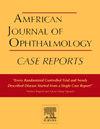A rare case of severe bilateral chorioretinal coccidioidomycosis in an immunocompromised pediatric patient with Takayasu Arteritis
Q3 Medicine
引用次数: 0
Abstract
Purpose
To report a case of severe bilateral coccidioidomycosis chorioretinitis in an immunosuppressed pediatric patient, demonstrating significant management challenges, therapeutic interventions, and a favorable outcome.
Observations
A 14-year-old female with a history of 1p36 microdeletion and Takayasu Arteritis (TA), managed with adalimumab and mycophenolate, presented with acute respiratory symptoms and bilateral vision impairment. She had severe bilateral diffuse chorioretinitis and an anterior chamber sample revealed coccidioidomycosis. Over the next few months, she underwent 14 serial intravitreal injections in each eye (1 amphotericin, 13 voriconazole), intravenous amphotericin B and fluconazole, and restarted on immunosuppressants for her TA. At 8 months following initial presentation, her vision remains 20/100 in the right eye and 20/125 in the left eye.
Conclusions and importance
This case illustrates a rare occurrence of coccidioidomycosis with bilateral chorioretinal involvement, necessitating aggressive and prolonged antifungal therapy. The successful salvage of both globes and vision in such a severe bilateral infection highlights the potential of intensive, multi-modality treatment strategies in similar cases. Further studies are warranted to understand the optimal management of chorioretinal coccidioidomycosis and the impact of systemic immunosuppression.
一个罕见的病例严重的双侧绒毛膜视网膜球虫菌病在免疫功能低下的儿童患者与高须动脉炎
目的报告一例免疫抑制的儿童患者发生严重的双侧球孢子菌病绒毛膜视网膜炎,显示出重大的管理挑战、治疗干预和良好的结果。观察1例14岁女性,有1p36微缺失和高须动脉炎(TA)病史,经阿达木单抗和霉酚酸酯治疗,出现急性呼吸道症状和双侧视力障碍。她患有严重的双侧弥漫性脉络膜视网膜炎,前房检查显示球虫菌病。在接下来的几个月里,她每只眼睛接受了14次连续玻璃体内注射(1次两性霉素,13次伏立康唑),静脉注射两性霉素B和氟康唑,并重新开始使用免疫抑制剂治疗TA。初次就诊后8个月,她的右眼视力为20/100,左眼视力为20/125。结论和重要性:本病例为罕见的球虫菌病伴双侧脉络膜视网膜受累,需要积极和长期的抗真菌治疗。在这种严重的双侧感染中,成功地挽救了球体和视力,突出了在类似病例中强化,多模式治疗策略的潜力。需要进一步的研究来了解绒毛膜视网膜球虫病的最佳治疗方法和全身免疫抑制的影响。
本文章由计算机程序翻译,如有差异,请以英文原文为准。
求助全文
约1分钟内获得全文
求助全文
来源期刊

American Journal of Ophthalmology Case Reports
Medicine-Ophthalmology
CiteScore
2.40
自引率
0.00%
发文量
513
审稿时长
16 weeks
期刊介绍:
The American Journal of Ophthalmology Case Reports is a peer-reviewed, scientific publication that welcomes the submission of original, previously unpublished case report manuscripts directed to ophthalmologists and visual science specialists. The cases shall be challenging and stimulating but shall also be presented in an educational format to engage the readers as if they are working alongside with the caring clinician scientists to manage the patients. Submissions shall be clear, concise, and well-documented reports. Brief reports and case series submissions on specific themes are also very welcome.
 求助内容:
求助内容: 应助结果提醒方式:
应助结果提醒方式:


